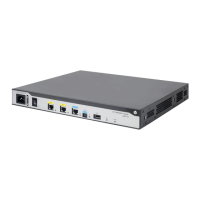78
Configuring the DHCP client
With DHCP client enabled, an interface uses DHCP to obtain configuration parameters from the
DHCP server, for example, an IP address.
The DHCP client configuration is supported only on Layer 3 Ethernet interfaces (or subinterfaces),
VLAN interfaces, and Layer 3 aggregate interfaces.
Enabling the DHCP client on an interface
Follow these guidelines when you enable the DHCP client on an interface:
• On some device models, if the number of IP address request failures reaches the
system-defined amount, the DHCP client-enabled interface uses a default IP address.
• An interface can be configured to acquire an IP address in multiple ways. The new configuration
overwrites the old.
• Secondary IP addresses cannot be configured on an interface that is enabled with the DHCP
client.
• If the interface obtains an IP address on the same segment as another interface on the device,
the interface does not use the assigned address. Instead, it requests a new IP address from the
DHCP server.
To enable the DHCP client on an interface:
Step Command Remarks
1. Enter system view.
system-view
N/A
2. Enter interface view.
interface
interface-type
interface-number
N/A
3. Configure an interface to use
DHCP for IP address
acquisition.
ip address dhcp-alloc
By default, an interface does not
use DHCP for IP address
acquisition.
Configuring a DHCP client ID for an interface
A DHCP client ID is added to the DHCP option 61. A DHCP server can specify IP addresses for
clients based on the DHCP client ID.
Make sure the IDs for different DHCP clients are unique.
To configure a DHCP client ID for an interface:
Step Command Remarks
1. Enter system view.
system-view
N/A
2. Enter interface view.
interface
interface-type
interface-number
N/A
3. Configure a DHCP
client ID for the
interface.
dhcp client identifier
{
ascii
string
|
hex
string
|
mac
interface-type
interface-number }
By default, an interface generates the
DHCP client ID based on its MAC address.
If the interface has no MAC address, it uses
the MAC address of the first Ethernet
interface to generate its client ID.

